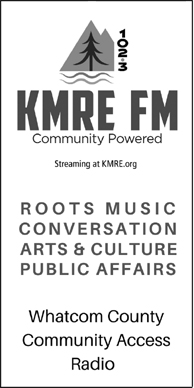Life Before Flowers
(All mushroom photos are by Fred Rhoades)
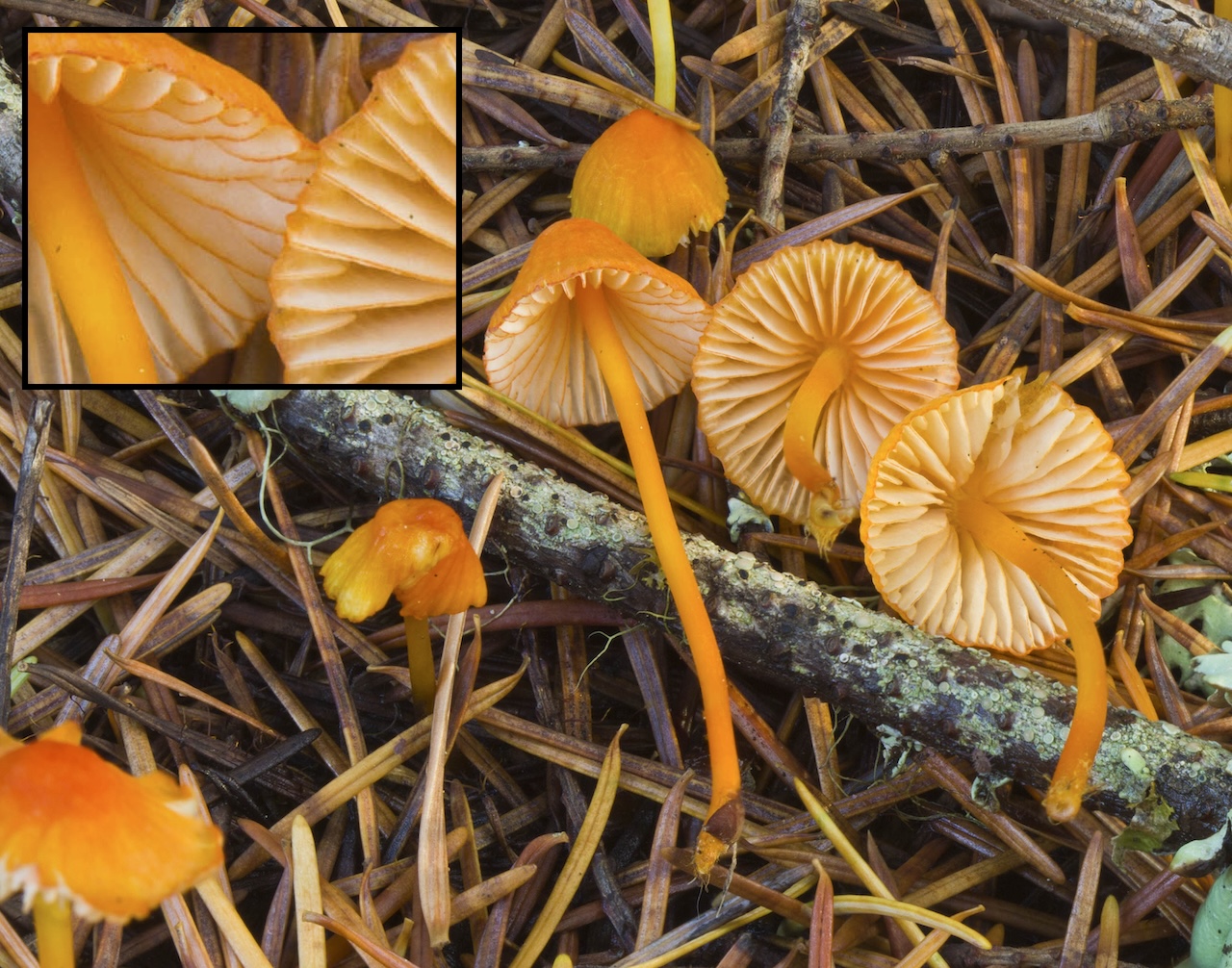
Mycena strobilinoidea – a striking, bright, reddish-orange species that occurs in needle beds in the mountains; a group of Mycenas have gill edges colored the same as the caps (see inset).
Part I
by Fred Rhoades
I’d like to start an occasional part of this series that provides descriptions of different mushrooms that are relatively easy to identify to genus group, but show considerable diversity. Such a look will help you recognize some of the more common things you see in our local habitats and gain an appreciation for their diversity and the important roles they play in the environment.
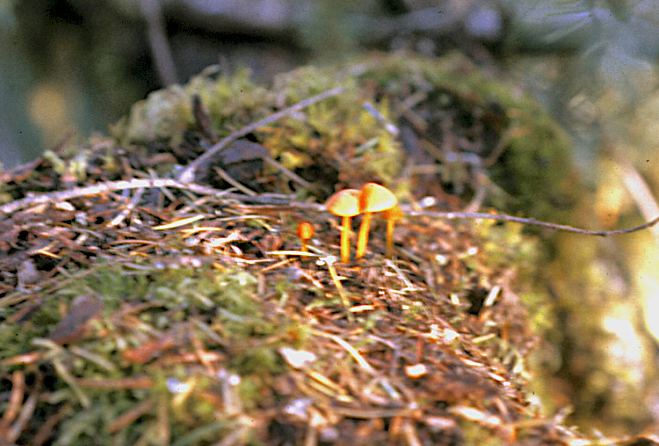
Mycena strobilinoidea – The same species 100 feet off the ground in a perched needle bed on a Douglas fir branch. Mycenas will grow wherever there is material to decompose.
I say genus group because most modern mycologists are now separating classical genera into newly named genera that are based on the true evolutionary relationships as shown by analysis of DNA. For simplicity, I’ll mostly use the traditional “Friesian” genus name for all. Elias Fries was the 18th century, Swedish “Linnaeus of Mycology” who figured out, at least we used to think, how to clearly identify the genus of mushrooms.
Mushrooms Formerly Classified
I’ll start with the mushrooms formerly all classified in the genus Mycena. There are over 50 of these in the Pacific Northwest. They and are richly diverse, often colorful or otherwise beautiful, diminutive species occupying a variety of habitats.
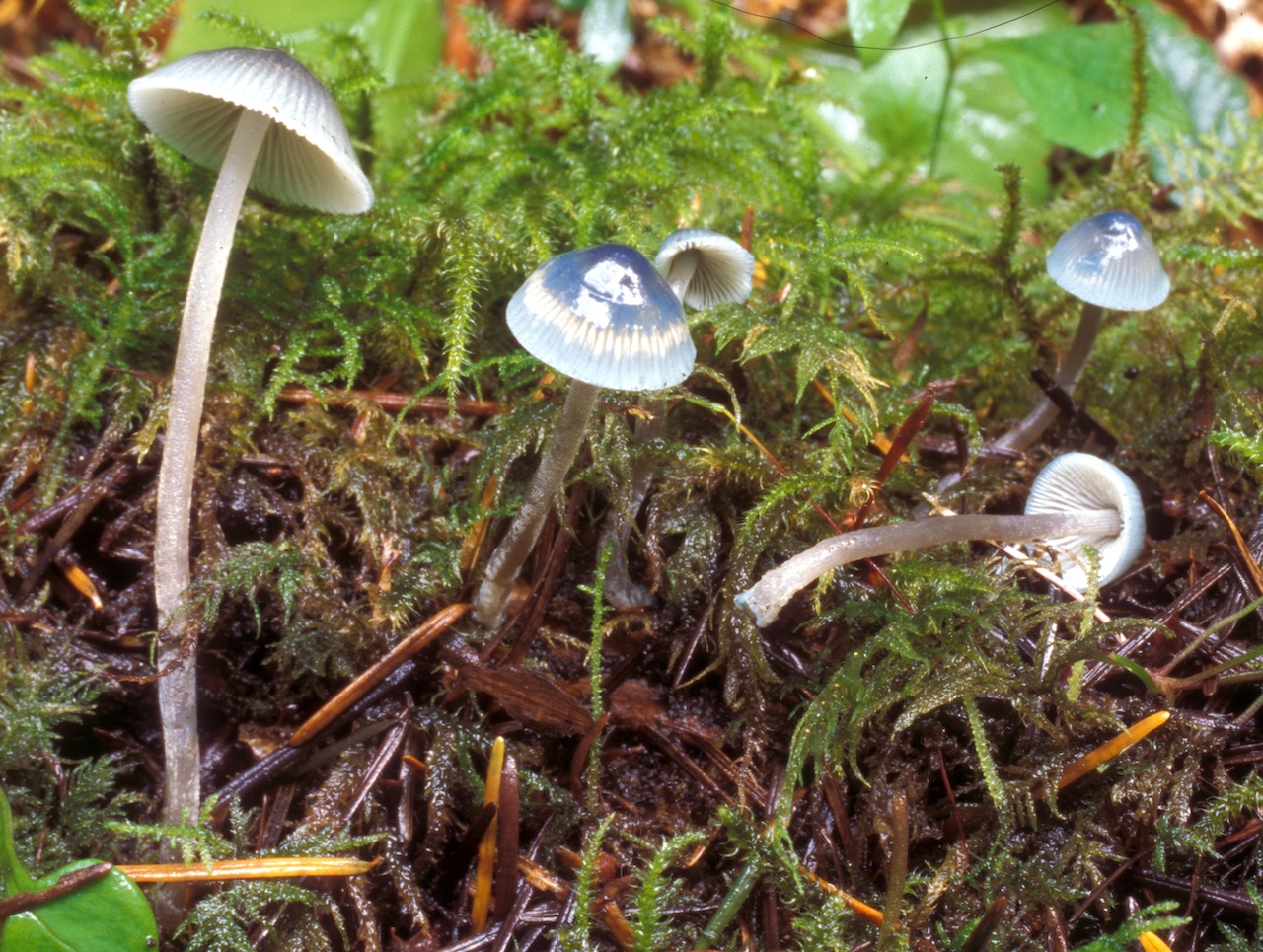
Mycena amicta – Our fairly common blue species that is a decomposer of wood. It occurs in small
groupings. The depth of the blue color varies across individuals and can sometimes be restricted to only the stipe bases of individuals that are otherwise dull reddish brown.
A couple of years ago, I wrote a couple of columns about the plant-decomposing activities of mushrooms (“Moldy Rotters,” June and July 2023 Whatcom Watch). In those I described different species that function in that role, including some in Mycena. Also, there is a complete discussion of how the decomposers work to break down the plant parts they live on.

Mycena citrinomarginata is common in lawns. As the name suggests, the color is slightly yellowish and the gill edges are tinted the same as the cap surface. Inset shows gills.
Originally, Fries described the genus Mycena as mushrooms with small cone-shaped caps less than one inch across with slender, hollow stipes, and white spores. They are all decomposers and the hyphae in their mycelia are known to produce both cellulose- and lignindegrading enzymes, so they are important plant-litter-decomposing species. These fungi are perennial, with mycelia that live from year to year in habitats that include decaying plant bits: leaves, twigs, larger wood and other plant parts. Each year, the mycelium invades newly available substrate, and, when conditions are right for each species, produces a crop of mushrooms, often growing in tight clusters (from wood) or in diffuse troops (from needles and leaves).
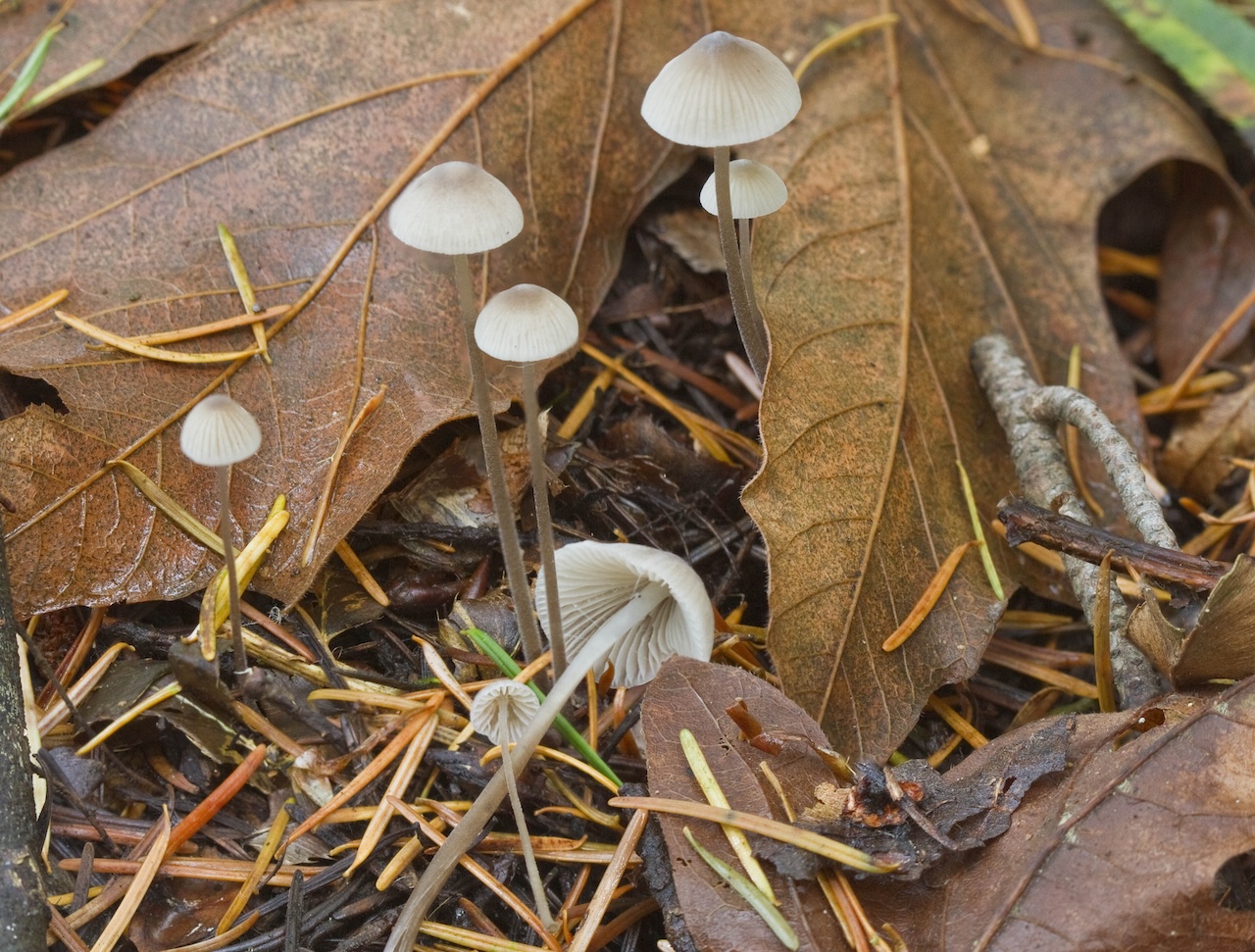
Mycena leptocephala – One of the “Bleach Mycenas.” There are many gray Mycenas that are most easily distinguished by microscopic characters. A few, like this one that occurs in troops on decaying needle and leaf beds, smell like bleach when crushed.
Problems in Naming Organisms
The genus Mycena in the Friesian sense exhibits one of the problems that is happening now in the naming of many organisms, particularly as we understand more about their evolutionary relationships. Species in the genus are being distributed among at least seven other genera. As now circumscribed, true Mycenas have spores that turn blue-black in iodine (amyloid) and their DNA sequences are similar enough to cluster them in the same location on an evolutionary tree.

Mycena (Atheniella) aurantiidisca – A beautiful needle-decomposer with bright orange colors and white rims on the cap and yellow stipes. Because the spores don’t change color in iodine and because its DNA sequence places it outside true Mycenas, it gets a new genus name, Atheniella.
Among the other genera separated from this genus are Atheniella (a lovely name I think — one common white one and several that are brightly colored with non-amyloid spores), Hemimycena (most of the other white species with non-amyloid spores), Phloemana (one common species with more rounded caps and perhaps another interesting smaller one), Roridomyces (very slimy stipe), Mycopan and Hydropus (both impossible to separate without DNA). As far as I am concerned, when you are beginning, all these should just be regarded as Mycena.
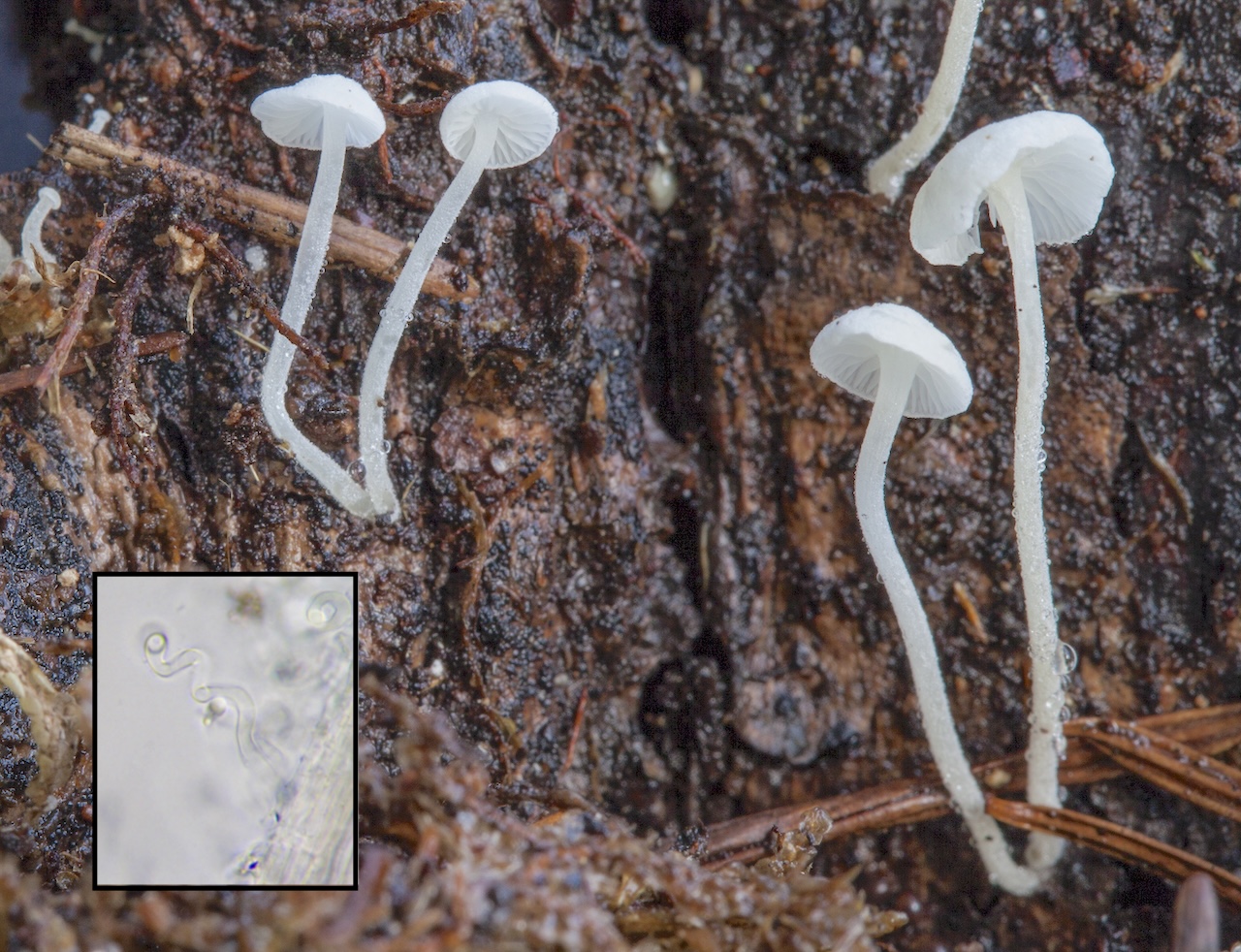
Mycena (Hemimycena) tortuosa -The white Mycenas are mostly placed in the new genus Hemimycena. If you have a microscope, this species is easy to identify when you see the corkscrew-shaped cells on stipe side (inset) which give the species its name.

Mycena (likely a Phloemana) oregonensis – This bright orange, tiny (caps 2-3 mm across) species occurs in troops on decaying needles and cedar scales.
Although some traditional Mycenas are brightly colored, many are some shade of gray or brown. Unless they have some other, notable features such as odd structure, tinted gill edges, odor or sliminess, these “dull” species are quite difficult to differentiate. To do so with confidence, one needs microscopic features of spores and sterile cells or even DNA sequences.
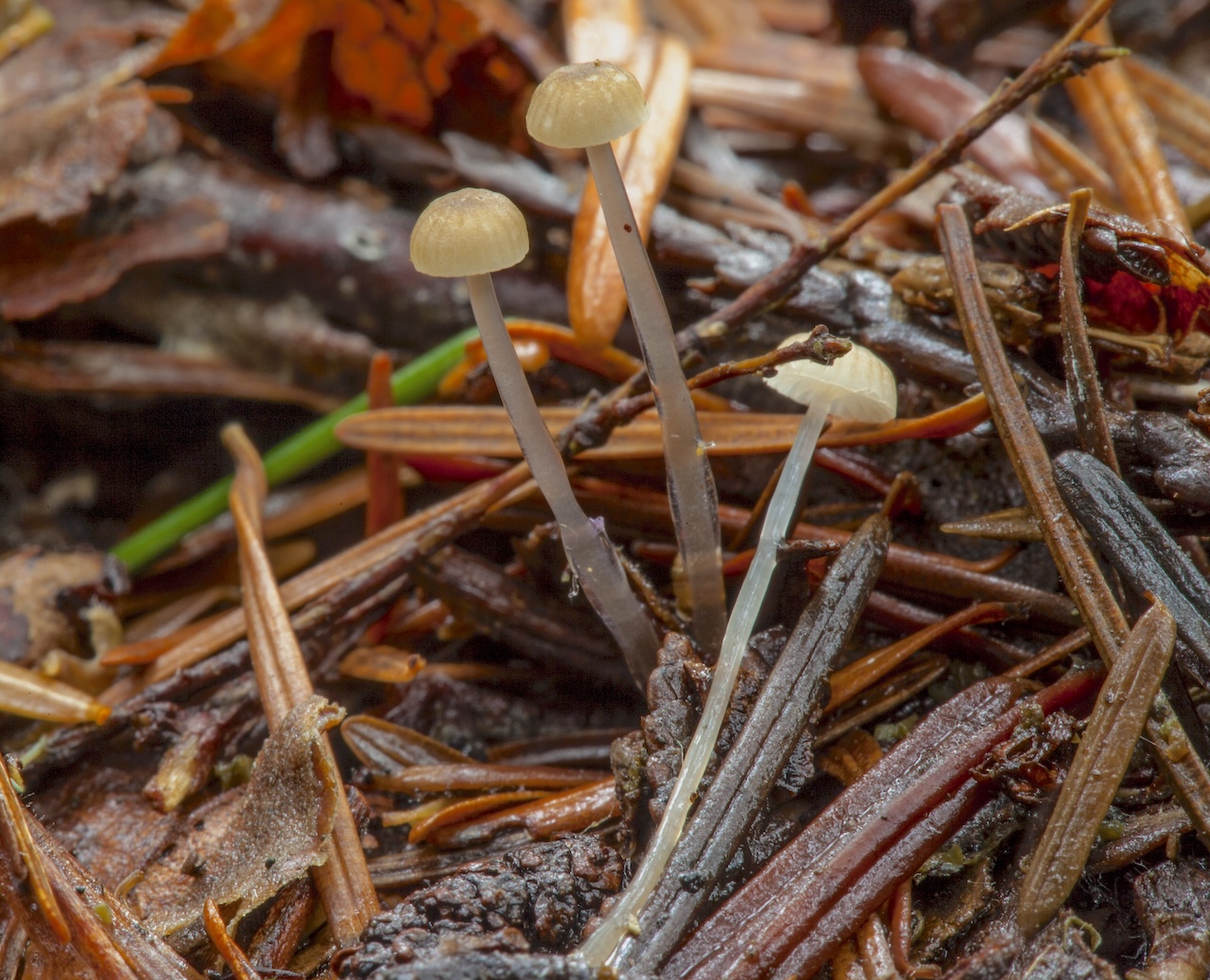
Mycena (Roridomyces) rorida – This small species has a distinctively slimy stipe, with a layer of goo that in wet weather can be almost as thick as the stipe itself.
The amazing thing about many of the mushrooms in all genera in the Pacific Northwest is the large number of undescribed species that are now known only by their DNA sequences. Originally thought to be other species (particularly European look-alikes), there are now dozens of these waiting for experts to go through the process of describing them and assigning scientific names.

Mycena stylobates – An interesting small gray-brown species whose stipe adheres to the substrate of needles and scales by a small disc.
The descriptions in the captions to the illustrations may help you identify some of these more common species by habitat, color and other macroscopic features. Here I have used the Mycena names these have been commonly known by (with segregate genus name in parentheses).
In the early 1980s, I undertook an interesting project involving Mycena species at the old Mt. Baker High School tree farm off South Pass – Silver Lake Park Road. For four to five years, I followed the fruiting of all the Mycenas in this grid of young trees. What I found was that the same species came up in the same places year after year. And in about the same sizes of clusters. I took this as an indication of the perennial nature of these fungi. Their mycelia continue to live in the new needles that fall on them and each year produce new fruiting bodies. As I mentioned in the article on decomposition, this is a general feature of most fungi that decompose things. As long as there is continued “food” for them they will live many years. Mycenas are too small to be eaten. Some are known to be poisonous and all should be avoided. They are a beautiful presence with important ecological roles.
____________________________________
From 1977 to 2009, Dr. Fred Rhoades was an instructor of biology at Western Washington University











